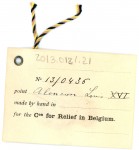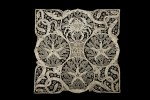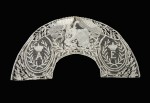 The Smithsonian Institution’s National Museum of American History has a collection of beautiful Belgian laces made during World War I at the behest of future President of the United States Herbert Hoover. Hoover’s name is nowadays most commonly associated with the lack of relief for the destitute of the Great Depression — the notorious tent cities of the homeless and poverty-stricken were famously called Hoovervilles — but before he was president Herbert Hoover was actively involved in relief efforts. As head of the Food Administration under Woodrow Wilson, Hoover was in charge of the administration’s food and fuel conservation programs during the war, but before that, when war first broke out in 1914, Hoover ran the Committee for Relief in Belgium (CRB) which organized the distribution of food supplies to ten million people in occupied Belgium.
The Smithsonian Institution’s National Museum of American History has a collection of beautiful Belgian laces made during World War I at the behest of future President of the United States Herbert Hoover. Hoover’s name is nowadays most commonly associated with the lack of relief for the destitute of the Great Depression — the notorious tent cities of the homeless and poverty-stricken were famously called Hoovervilles — but before he was president Herbert Hoover was actively involved in relief efforts. As head of the Food Administration under Woodrow Wilson, Hoover was in charge of the administration’s food and fuel conservation programs during the war, but before that, when war first broke out in 1914, Hoover ran the Committee for Relief in Belgium (CRB) which organized the distribution of food supplies to ten million people in occupied Belgium.
Hoover wasn’t in government at the time. He wasn’t even in the United States. He was living in London, a wealthy mining engineer and investor who translated Renaissance mining tracts with his wife Lou in his spare time. That translation is considered the standard for its clarity of language and extensive scholarly footnotes and is still in print today. He was drawn into relief work after World War I broke out and tens of thousands of American citizens suddenly found themselves stranded in London. Hoover organized a committee to get them back home and was so effective that in October of 1914 the U.S. ambassador to the Court of St. James asked Hoover to take on a far more onerous job: keep all of Belgium from starving to death.
 Belgium had been invaded by Germany at the start of the war and famine immediately became a very real prospect. The small country only produced enough food to supply 20-25% of the population, but whatever food was available was requisitioned by the occupiers to supply the troops. Britain put Germany and the occupied countries under blockade making food imports nigh on impossible.
Belgium had been invaded by Germany at the start of the war and famine immediately became a very real prospect. The small country only produced enough food to supply 20-25% of the population, but whatever food was available was requisitioned by the occupiers to supply the troops. Britain put Germany and the occupied countries under blockade making food imports nigh on impossible.
That was the Gordian knot Hoover had to cut through. He was able to arrange for the relief supplies to be shipped to Belgium where the CRB monitored their distribution by the Comité National de Secours et d’Alimentation (CNSA), the Belgian organization dedicated to famine relief. The CRB personnel weren’t just passing the time of the day. They had to be involved in every step of the distribution process because as occupied Belgians, CNSA personnel were legally bound to follow German orders. The primarily British and American CRB staff was under no such obligation. Their job was to ensure the food made it to Belgian plates and they did it well. The CRB raised funds, shipped 5.7 million tons of donated food past Germany’s unrestricted U-boat warfare and then literally fed Belgium from 1914 through 1919.
 Hoover’s concern wasn’t just to keep Belgians from mass starvation. He also arranged for thread to be distributed to Belgian lace makers and for the sale of their finished lace to buyers in Allied countries. Belgium had been famous for its delicate handmade laces since the 17th century, and while industrialization and mass-production had hobbled the traditional craft, Queen Elisabeth of Belgium instituted promotional and improvement programs had helped spur a revival of interest in handmade lace just before World War I.
Hoover’s concern wasn’t just to keep Belgians from mass starvation. He also arranged for thread to be distributed to Belgian lace makers and for the sale of their finished lace to buyers in Allied countries. Belgium had been famous for its delicate handmade laces since the 17th century, and while industrialization and mass-production had hobbled the traditional craft, Queen Elisabeth of Belgium instituted promotional and improvement programs had helped spur a revival of interest in handmade lace just before World War I.
The Belgian lace committees worked closely with the “Commission for Relief of Belgium” as the work on behalf of the lace makers became even more important during World War One. Several famous Belgian artists were enlisted to make new designs. Among them were Isidore de Rudder, his sister Maria de Rudder, Charles Michel, and Juliette Wytsman, who designed some of the War Laces that are now part of the collection at the National Museum of American History.
World War One laces often included names of people, places, inscriptions, and dates; a characteristic not usually found in other lace work. The lace often incorporates the coats-of-arms or national symbols of the Allied Nations as well as the nine Belgian provinces in recognition of the help received. It was hoped that these distinguishing elements would appeal to generous people around the world who might buy these laces in support of the Belgian people.
 Sometimes the appeal was even more direct. This exquisite banner panel features a pair of cupids holding a banner inscribed “Augusta-Virginia,” the name of the mother of the Vicomtesse de Beughem. The Vicomtesse, an American married to a Belgian aristocrat, was one of four women in charge of the Lace Committee. It is believed she commissioned the banner in honor of her mother, Augusta Virginia Mitchell. One of the other three women, Mrs. Brand Whitlock, wife of the US ambassador to Belgium, commissioned this table cloth with the seals of the United States, Belgium and the Whitlock family crest.
Sometimes the appeal was even more direct. This exquisite banner panel features a pair of cupids holding a banner inscribed “Augusta-Virginia,” the name of the mother of the Vicomtesse de Beughem. The Vicomtesse, an American married to a Belgian aristocrat, was one of four women in charge of the Lace Committee. It is believed she commissioned the banner in honor of her mother, Augusta Virginia Mitchell. One of the other three women, Mrs. Brand Whitlock, wife of the US ambassador to Belgium, commissioned this table cloth with the seals of the United States, Belgium and the Whitlock family crest.
The program ultimately kept 50,000 lace makers in Belgium working from 1914 through 1919.
 The war laces in the Smithsonian collection are not on public display, but they have been digitized and can be viewed online. It’s a gasp-generating browse, even though I dearly wish the pictures were larger. I know, I know… I always wish the pictures were larger, but the minute details of this lace just beg to be viewed in extreme closeup. It’s a little awkward to navigate, but you can feast your eyes on the minutiae by clicking on the name of the object. This takes you the catalogue entry. Scroll down to the bottom for additional images. Those are detail images, so while you can’t see the whole piece zoomed all the way in to the stitching, you can explore the a section of the lacework in satisfying detail.
The war laces in the Smithsonian collection are not on public display, but they have been digitized and can be viewed online. It’s a gasp-generating browse, even though I dearly wish the pictures were larger. I know, I know… I always wish the pictures were larger, but the minute details of this lace just beg to be viewed in extreme closeup. It’s a little awkward to navigate, but you can feast your eyes on the minutiae by clicking on the name of the object. This takes you the catalogue entry. Scroll down to the bottom for additional images. Those are detail images, so while you can’t see the whole piece zoomed all the way in to the stitching, you can explore the a section of the lacework in satisfying detail.
 One of my favorites is Table Mat With English Scene which has an unbelievable allegorical depiction of the coronation of British King George V in 1911. The image started out as a cartoon by Bernard Partridge published in Punch Magazine which was the converted into lace using the Point de Gaze technique. The Isidore de Rudder Designed Pillow Top goes in a completely different direction, commemorating the battle at the Yzer River with a glorious sea creature design in Point de Venise needle lace. I love the Monogrammed Fan Leaf with Designer’s Name because while it has the monograms of Belgian King Albert I and Queen Elisabeth writ large on either side of the Belgian Lion, it
One of my favorites is Table Mat With English Scene which has an unbelievable allegorical depiction of the coronation of British King George V in 1911. The image started out as a cartoon by Bernard Partridge published in Punch Magazine which was the converted into lace using the Point de Gaze technique. The Isidore de Rudder Designed Pillow Top goes in a completely different direction, commemorating the battle at the Yzer River with a glorious sea creature design in Point de Venise needle lace. I love the Monogrammed Fan Leaf with Designer’s Name because while it has the monograms of Belgian King Albert I and Queen Elisabeth writ large on either side of the Belgian Lion, it  also has the names of designer Juliette Wytsman and the manufacturer Maison Daimeries-Petitjean in very petite cursive under the monogrammed initials. It’s incredible to me that it’s even possible to write your name so small and clear in Point de Gaze needle lace. Oh, and here’s one for Supreme Court Justice Ruth Bader Ginsburg: Collar with Peace Doves.
also has the names of designer Juliette Wytsman and the manufacturer Maison Daimeries-Petitjean in very petite cursive under the monogrammed initials. It’s incredible to me that it’s even possible to write your name so small and clear in Point de Gaze needle lace. Oh, and here’s one for Supreme Court Justice Ruth Bader Ginsburg: Collar with Peace Doves.